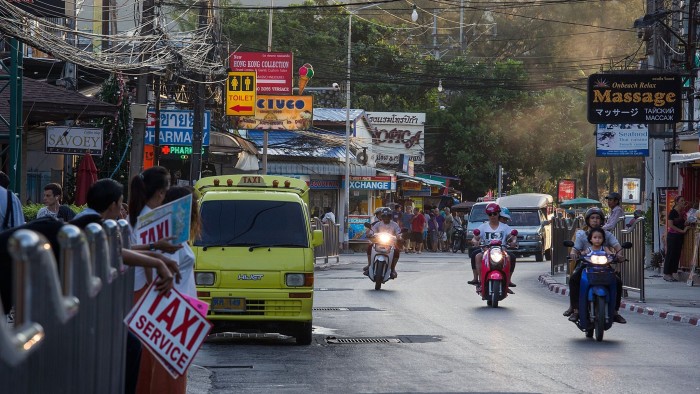Uber picks Bangkok for launch of first motorbike taxi service

Roula Khalaf, Editor of the FT, selects her favourite stories in this weekly newsletter.
Uber has picked Bangkok for the launch for its first motorbike taxi service, as the ride-hailing company strives to offset huge losses in China by expanding its business elsewhere in Asia.
The pilot “UberMOTO” operation launched on Wednesday is the US company’s next step to widening its fleet beyond regular cars, embracing vehicles such as the three-wheeled autorickshaws, popular in markets such as India and Indonesia.
The Thai move is also a counter to the increasingly co-ordinated opposition to Uber’s growth in Asia from well-funded rivals, led by China’s Didi Kuaidi and including India’s Ola and Southeast Asia-focused GrabTaxi.
Uber’s Bangkok gambit is an attempt to capitalise on the popularity of the orange-vested motorbike taxis who help residents wend their way through the city’s sometimes throttling traffic. The company could hardly have chosen a better day for its launch, as hordes of morning commuters were forced on to the road on Wednesday by lengthy delays on the BTS SkyTrain urban rail service.
However, Uber is not the first to enter that segment of the market. GrabTaxi launched a motorbike service in Bangkok last year, and offered a discount to travellers caught up in Wednesday’s rail troubles.
“Motorcycles are part of the commuting culture in Thailand,” said Douglas Ma, Uber’s head of Asia expansion. “Uber’s goal is to provide safe, affordable, reliable transportation at the push of a button, everywhere for everyone.”
San Francisco-based Uber’s expansion plans in Southeast Asia and India are taking on particular significance given its struggles in China, where it has invested heavily but is struggling to gain ground on Didi Kuaidi.
Travis Kalanick, Uber’s founder, said this month that the company lost more than $1bn in China last year and that the key now was whether it could “contain the irrational long enough to get to the point where the world does get rational”.
Last year Didi Kuaidi, Ola and GrabTaxi, along with Uber’s US-based rival Lyft, formalised an anti-Uber alliance to halt the company’s rapid rise in Asia.
The Thai motorbike move is Uber’s latest attempt to find ways of delivering new services to suit budget-conscious Asian consumers.
The group first accepted cash for rides in India. It also launched — with mixed results — a pilot autorickshaw service in Delhi that ended late last year and has not yet been extended.
Thailand’s motorcycle taxis are noted for their convenience and manoeuvrability, if also for cutting across other traffic and mounting already crowded pedestrian sidewalks. Uber said it was working with Thai authorities and road safety campaigners to ensure its drivers obey road laws, including a much-ignored rule forcing passengers to wear helmets.
Uber will also have to adapt to wide variations in the use of motorcycle taxis around the region. The market is developing in India and is big in Indonesia, Southeast Asia’s most populous country, where Gojek already has a strong position.
In contrast, in Vietnam where Uber already offers small hatchback cars, the roads of Ho Chi Minh City and Hanoi swarm with private bikes that are many people’s favoured means of transport. In Yangon, Myanmar’s biggest city, motorcycles are banned, although enforcement is patchy.
Comments